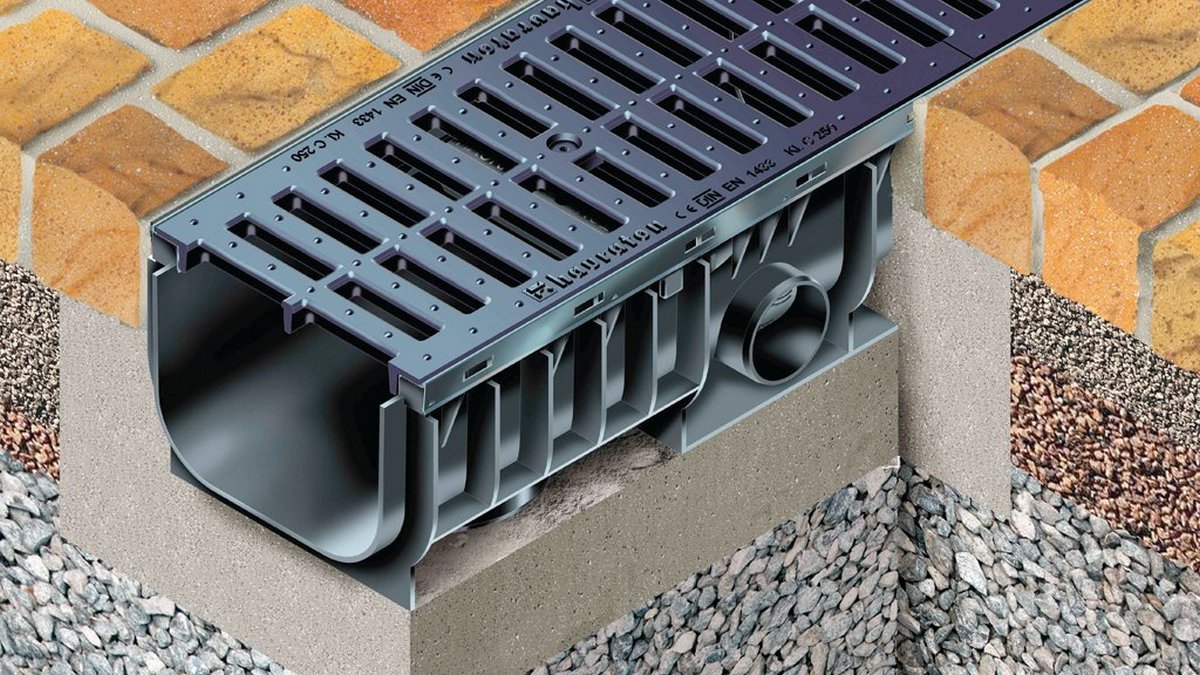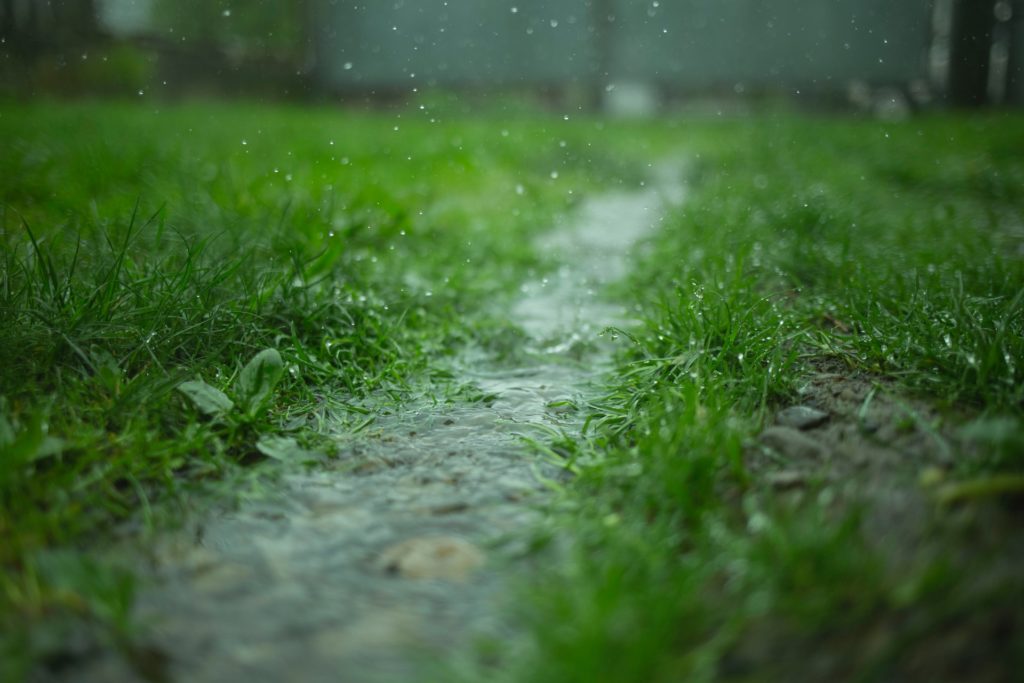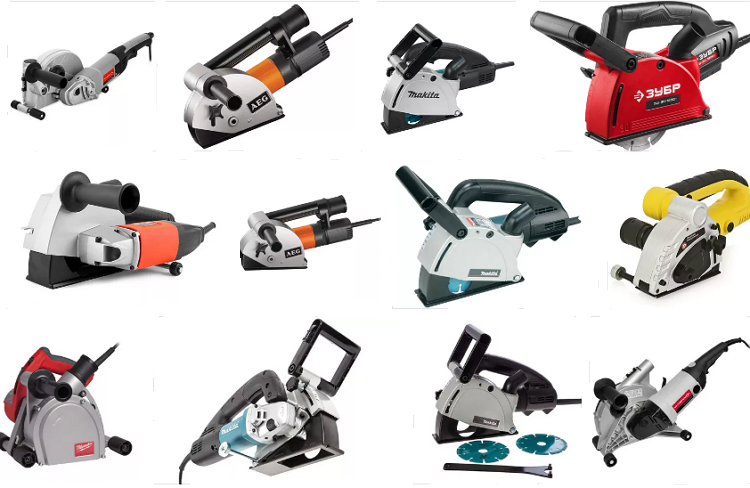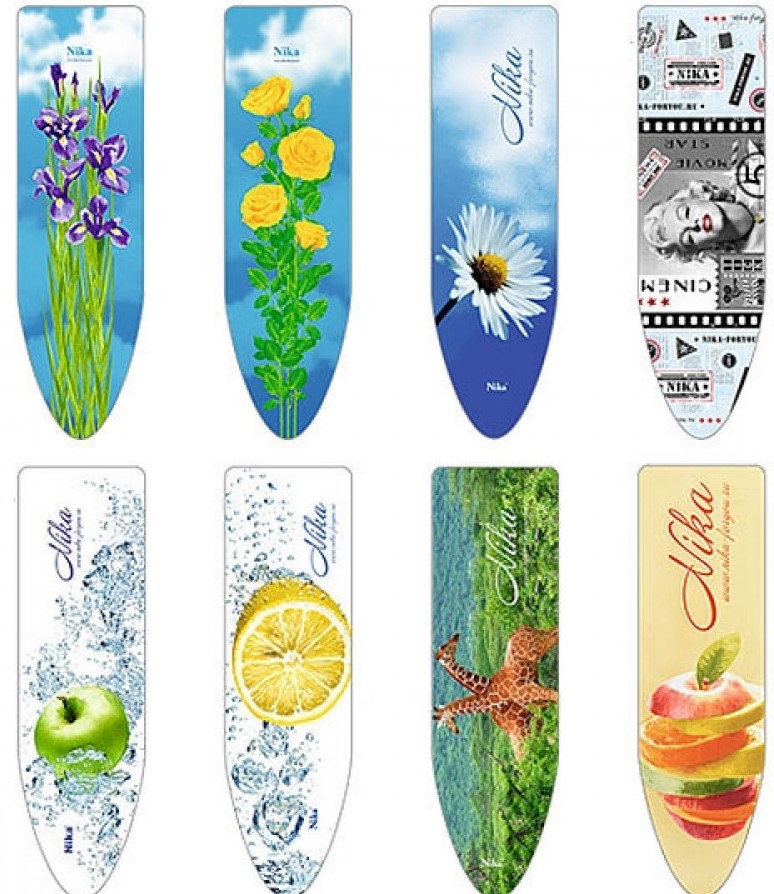Rating of the best surface drainage systems for 2025

In order to prevent damage that can be caused by heavy rainfall or melt water, the adjacent plots and structures on them can be equipped with surface drainage systems. Such structures serve to collect and remove excess precipitation, which can harm buildings, the surrounding area, and agricultural plantations.

Content [Hide]
- 1 General information about surface drainage
- 2 Advantages of surface drainage systems
- 3 Modern types of drainage from the surface
- 4 Surface drainage device
- 5 Surface drainage design
- 6 Difficulties of choice
- 7 Ranking of the best surface drainage (main components) for 2025
- 8 Conclusion
General information about surface drainage
The systems under consideration can be controlled and uncontrolled. For the latter case, in general, it is difficult to call the entire structure a system in full measure, because in its essence, as such, the structure does not exist. Uncontrolled drains do not have single points of water collection, nor do they have specific points for their removal - they are simply chosen at random and are located where they are most incapable of harming the surrounding infrastructure.
Controlled removal of water over the surface includes the presence of:
- Separate linear gutters;
- Separate drain systems;
- Full-fledged structures from gutters, drains, sand inlets and storm water inlets.
Thus, controlled systems can simultaneously and purposefully collect and divert sediments from a certain area into the sewer or outside the serviced area.
In general, the considered drainage structures are intended for:
- Preservation of the foundation and walls of the structure from flooding and getting wet;
- Prevention of flooding of basements and swamping of adjacent territories;
- Protection of blind areas of the house, paths and beds, landscape design components from erosion by melt water flows.
In addition, if a special prefabricated collector is built into the drainage system, then the accumulated water can even be irrigated. In any case, if you do not create a water drainage system, then excessive rainfall can easily destroy the foundation of the house, disfigure the surrounding landscape or become a catalyst for the formation of mold in residential buildings.
Advantages of surface drainage systems
The undoubted advantages of the construction of such devices include:
- A significant reduction in the volume of earthworks, which will reduce the financial costs of materials and the arrangement of an underground sewer line;
- Minimal destruction of the soil structure, which will help to avoid their subsidence in the future, as well as reduce the risk of subsidence / weakening of the foundations of houses, road surfaces, various pedestals;
- The ability to mount devices directly on an existing coating that does not need to be destroyed / deformed;
- Long service life (both concrete and polymers can last for decades, even under considerable loads);
- Service comfort and reduced maintenance requirements (individual drainage elements, for example, sand traps, are very easy to clean);
- Decorative grilles have an aesthetic appearance and emphasize the originality of their surroundings;
- The overall efficiency of the system (a well-assembled design will protect its owner from the negative effects of weather precipitation for a long time).
Modern types of drainage from the surface
The devices in question are one of the varieties of storm sewers that can be equipped both in public areas and on private land. They can be built in two systems:
- Linear - it consists of gutters, a sand trap and a storm water inlet (optional). Such a device will perfectly cope with the collection / removal of precipitation over large areas. For its organization, a minimum of earthworks will be required. The installation of linear type devices is mandatory for areas on muddy soil with a slope of more than 3 degrees.
- Point - it consists of several locally located surface storm water inlets, which are connected underground by one pipeline. Point variation will be the best solution if most of the precipitation enters the storm water inlet from the roof. Also, its arrangement will become appropriate in small areas that do not have extensive undeveloped areas.
IMPORTANT! Although each of these systems is quite effective on its own, professionals believe that their combination will bring the owner the best possible result.

Surface drainage device
To create surface drainage systems (both linear and point), various components are used, which, when assembled, each play their own role, forming a single effective working result.
Chutes (trays)
They are also called drainage trays, and they are the most important part of the system, designed to collect melt water and precipitation and direct them to a specific place - into the sewer or outside the site. Gutters can be made from the following materials:
- Plastic - such products are lightweight and easy to install. Especially for them, various adapters, plugs, fasteners, etc. were invented. - all these elements are designed to facilitate the assembly and installation of the entire structure. Plastic models have the properties of frost resistance and relative strength, but they are limited in terms of load - they can withstand no more than 25 tons. Such trays are mounted in suburban areas, areas for pedestrians, special bike paths, i.e. wherever excessive mechanical stress is not expected.
- Concrete is the strongest and most durable variation, which is more than affordable at a price. Focused on very solid loads. Their installation is necessary for areas with transport access (garage area or access roads). Cast iron or steel gratings are always installed above them. However, due to the peculiarities of the device for fixing them on the surface, it will not be possible to quickly change their position.
- Polymer concrete is a combination of the two samples described above, which is the "golden mean", because it has absorbed their best qualities. Products are characterized by relatively low weight, can take significant loads, and the protective and technical performance is very high. However, the cost is also high. Due to its smooth surface, rare leaves, sand, branches, and other debris of both natural and anthropogenic origin do not linger in such gutters. Proper installation (along with occasional cleaning) will ensure these trays last as long as possible.
Sand receivers (sand collectors, sand traps)
This surface drainage element is designed to filter water from earth, sand and other fragmented materials.The component is equipped with a special basket where all extraneous debris is collected. If the sand trap is mounted in close proximity to the sewer, then such an arrangement will ensure its most efficient functioning. The sandbox, like the tray, has its own load limit. Due to the fact that it is an integral part of the entire system, it must be made of the same material as the rest of the key components. The upper part of it is very much like a gutter in shape, it is also closed with a drainage grate, so the component will not stand out too much on the territory. It is possible to increase the height of its immersion into the ground (for example, for installation below the freezing level of the soil), using the superstructure of one device over another.
The structure of the sandbox suggests the presence of outlets on the sides, which are needed to connect to an underground storm main. Outlet pipes with standard diameters are located above the bottom area, so that the filtered fragments remain there. The element in question can also be made of synthetic polymers, concrete or polymer concrete. The traditional equipment usually includes drainage grates made of plastic, cast iron or steel. The receiver must be selected depending on the forthcoming volume of discharged precipitation and the total load for the area of its installation.
rainwater inlets
Rain and melt water, collected by downpipes from the roof of the building, fall on a special blind area. In these areas, it is necessary to install storm water inlets, which are cubic containers. They are required without fail in those areas where surface drainage of a linear type is equipped.
Rain inlets can also perform the function of a sand trap, for which a garbage collector is added to them. This additional element must be periodically cleaned in order to eliminate unpleasant odors from the sewer. In addition, storm water inlets can be supplemented with special nozzles connecting them to underground pipelines. The considered system drainage surface component is made of cast iron or durable plastic. It can also be equipped with a top grate, which will prevent large fragments of debris from entering the tank.
Drainage gratings
They are an integral part of surface drainage and are designed to take on most of the mechanical impacts. They are a visible element and therefore should (in most cases) be decorated.
These gratings are categorized based on various degrees of service loads. So, for suburban and home gardens, models of class "A" or "C" are intended, which can be made of copper, steel or plastic. Cast iron products (classes "F" or "D") are particularly durable, and they are used in areas where there is an increased traffic load (up to 90 tons). However, cast iron is extremely susceptible to rust, therefore it will require periodic protective painting, however, in terms of strength indicators, there is simply no alternative for it. If we talk about the service life of gratings, then cast iron can withstand 25 years (with proper care), steel - about 10 years, and plastic will require replacement after 5 years.
Surface drainage design
The calculation of the considered type of drainage should be carried out in accordance with the hydroproject, which takes into account all the smallest nuances: the features of the adjacent landscape, the intensity and volume of precipitation, and much more. Based on the calculations, the extent of the system and the number of points for each component are determined.
For suburban or suburban areas, it will be enough to draw only a plan where to mark the location of all the elements. And already in this way it will be possible to calculate the number of gutters, storm water inlets (sand inlets), pipes and gratings. The width of each channel can be selected based on the bandwidth. For trays, the optimal width will be variations of 100 millimeters. For high rainfall areas, the gutters can reach a width of 300 millimeters. Separately, it is worth paying attention to the diameter of the branches. The classic section of the pipes is 110 millimeters. Accordingly, if the exit hole has a different size, you will have to use an adapter.
High-quality and fast flow through the channel will help to install the system on a surface with a slope. It is possible to artificially organize such a bias in the following ways:
- Use the natural slope of the landscape;
- Form a slope through appropriate earthworks;
- Use trays of various heights (the method is effective only for serving small areas);
- Install channels whose inner surface initially has a slope (this includes only concrete structures).
Difficulties of choice
IMPORTANT! As follows from the above, it is extremely difficult to find a completely ready-made surface drainage system for sale, because its formation is a strictly individual process.Although some companies may provide entire lines of systems, they will differ only in the material of manufacture, but not in the unity of dimensions and the total number of elements used in them. Therefore, each buyer tries to purchase drainage components separately to create a complete system from them.
When purchasing such parts, you must rely on the following recommendations:
- If it is planned to install a linear surface drainage system in a small area, then the only gutter connected to the drainage pipe can become the main structure of the entire structure. For a small amount of wastewater, there will be no need for multiple connections to a single drain.
- For linear devices, most often, gutters with slopes will not be needed, but for point variations, they will be vital in 90% of cases.
- For point systems, you will definitely have to stretch the connection to each individual drain. Therefore, they will be able to serve much larger areas, but the number of drains purchased for them should not be limited to single components. In this case, it is generally preferable to purchase real gutters instead of trays.
- Trays and gutters with an internal slope will be absolutely useless for sites located on the hills, as well as in small areas (a slight slope, even due to gravity, will not give much force to the flow). Such an acquisition may result in unnecessary financial expenses.
Ranking of the best surface drainage (main components) for 2025
Chutes (trays)
3rd place: "TechnoNIKOL TN (PVC; 1.5 m; gray; gloss; 1 pc) TN563111"
votes 1
This gutter is a sample made in the form of a semicircular channel. Its main function is to collect and drain rain or melt water into the downpipe. Easy to mount in any type of system. Production material - PVC, diameter - 125 millimeters, segment length - 1.5 meters, width - 128 millimeters, wall thickness - 2.5 millimeters, segment weight - 900 grams. The recommended cost for retail chains is 332 rubles.

- Easily integrated into any system;
- budget cost;
- Small piece weight.
- Not detected.
2nd place: "Ecoteck Trickling green DI 14613000"
votes 0
This model can be used with any type of drainage system located on the surface. The action is aimed at preventing erosion damage and protecting decorative landscaping. There is room for a hole for a landscape pin. Durable construction holds up well in all weather conditions. The sectional shape is rectangular, the material of manufacture is plastic, the length of the segment is 60 centimeters, the width, mm, is 275.4, the weight, kg, is 0.4. The recommended cost for retail chains is 374 rubles.

- Presence of own bias;
- Resistance to temperature extremes;
- Not subject to cracking;
- Does not rust, does not discolor;
- Easy to move;
- Easily integrates with lawns and garden landscapes;
- It does not need to be fixed.
- Short cut length.
1st place: "MUROl 3 meters, brown 10166"
votes 0
This modification is designed to collect water from the roof, both from flat and pitched roofs, with a slope area of up to 180 sq.m. Scope — water waste superficial system. The cross-sectional shape is round, the material of manufacture is PVC, the diameter of the gutter is 130 millimeters, the length is 3 meters, the width is 130 millimeters, the wall thickness is 1.2 millimeters. The recommended cost for retail chains is 763 rubles.

- Available in long lengths (suitable for serving large areas);
- Made from high strength plastic;
- Withstands load class "C".
- Not detected.
Rain inlets (sand traps)
3rd place: "MAXDAN 300x300x300 with plastic grid, basket and partitions"
votes 0
The model is designed to provide reliable protection against melt water both in the immediate vicinity of the foundation and on the site itself. It can be installed in combination with other elements of the surface drainage system, and can also act as an independent functional device. To protect the plastic fixture from littering and damage by road transport, special protective grilles are used. The set also includes a plastic grate, a partition-siphon in the amount of 2 pieces, a basket. Production material - ABS plastic. The recommended cost for retail chains is 1005 rubles.

- Sufficient complete set;
- Durable ABS plastic execution;
- Possibility of independent work.
- Not detected.
2nd place: "MCH Chudej Roof Drain Gutter with Bottom Drain, D110, Standard, Black 325 E"
votes 1
This component of the surface system is used to drain rainwater into the sewer and to catch debris washed off the roofs of objects. The components are made of high-quality materials that are resistant to corrosion and environmental stress, and are equipped with a UV stabilizer. The product can be connected to gutters and trays, for this it is equipped with inlet inserts of various sizes, an anti-odor seal and a trash basket. Main diameter, mm - 110, production material - polypropylene, total length - 305 millimeters, width, mm - 155, height, mm - 235, net weight, kg - 0.9. The recommended cost for retail chains is 1670 rubles.

- Advanced functionality;
- Counteracting the sun's rays;
- The presence of a shutter against the smell.
- Not detected.
1st place: "Mir Santehniki LLC, model No. 553545675 with a cast-iron grate"
votes 0
The model is able to provide reliable protection against the effects of precipitation accumulation both in the immediate vicinity of the foundation and in the adjacent area. The package includes (in addition to the device itself): a cast-iron grate (slotted or "snowflake"), a partition-siphon in the amount of 2 pieces, a waste basket - 1 piece. The recommended cost for retail chains is 1970 rubles.

- Durable cast iron grate;
- The product is made from a combination of materials;
- Sufficient durability.
- Great weight;
- Requires periodic protective staining.
Drainage grids
3rd place: "Gidrolica Standart slotted cast iron 500x136x13 mm"
votes 0
This standard model is designed to provide protection against large channel debris in surface drainage systems. It can successfully cope with large mechanical loads and is characterized by a long service life. It can be laid on external channels and trays made of any material. Factory production involves the initial application of anti-corrosion protection, which will subsequently need to be periodically updated. The length of the cut is 50 centimeters. The recommended cost for retail chains is 1420 rubles.

- Durability;
- Work with trays from any materials;
- Adequate cost.
- Not detected.
2nd place: "LLC "Standartpark" series MAX DN200 HF, CL. E 253051"
votes 0
These grids are used in the arrangement of linear surface drainage from areas that are subject to heavy loads in terms of precipitation. They are used for mounting on drainage trays with a corresponding hydraulic section by means of a bolted connection. They protect against the ingress of leaves, branches and other street debris into the gutters, ensuring the safety of movement on the surface of the channels for pedestrians and vehicles. Withstand load class D400 - F900. The recommended cost for retail chains is 4260 rubles.

- Focus on servicing transport areas;
- Increased protection class;
- Durable material.
- High price.
1st place: "S'PARK & BASIC" model L750 MM, CL. S250"
votes 0
The model is designed to protect drainage channels with non-standard sizes or is used in places where the installation of channels is carried out at great depths. Made of high-strength cast iron, it has increased corrosion resistance, durability and special strength. The drainage grate for the surface drainage system withstands the load of medium traffic intensity (class C250). Scope of application: pedestrian areas, roadsides, parking lots, garages, car service enterprises. It is installed on channels with a width of 200-300-400 millimeters, which depends on the operating conditions. The recommended cost for retail chains is 5760 rubles.

- Sufficient strength;
- Ductile iron;
- Easy installation.
- Overcharge.
Conclusion
Owners of private plots have become increasingly interested in surface drainage systems. This is not surprising, since a well-designed and installed drainage system will properly protect the surface topography, the foundation of a house or other structure from heavy precipitation, which in the future can lead to the death of agricultural plantations, destruction of the structure of the building, flooding of the basement or other unpleasant consequences. Surface drainage must be installed in a complex, its components must be combined into a single system, because this is the only way to get rid of the harmful effects of precipitation.
new entries
Categories
Useful
Popular Articles
-

Top ranking of the best and cheapest scooters up to 50cc in 2025
Views: 131649 -

Rating of the best soundproofing materials for an apartment in 2025
Views: 127688 -

Rating of cheap analogues of expensive medicines for flu and colds for 2025
Views: 124516 -

The best men's sneakers in 2025
Views: 124030 -

The Best Complex Vitamins in 2025
Views: 121937 -

Top ranking of the best smartwatches 2025 - price-quality ratio
Views: 114978 -

The best paint for gray hair - top rating 2025
Views: 113393 -

Ranking of the best wood paints for interior work in 2025
Views: 110317 -

Rating of the best spinning reels in 2025
Views: 105327 -

Ranking of the best sex dolls for men for 2025
Views: 104363 -

Ranking of the best action cameras from China in 2025
Views: 102214 -

The most effective calcium preparations for adults and children in 2025
Views: 102010









